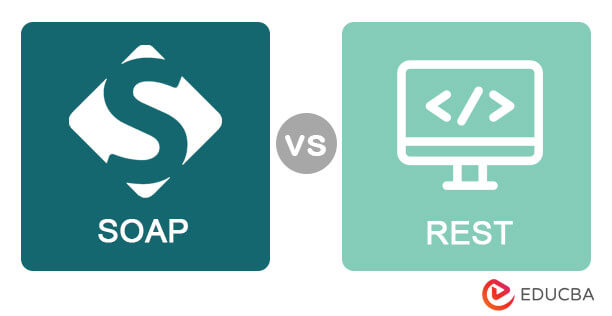Updated March 10, 2023
Difference Between SOAP vs REST
The article outlines the differences between SOAP vs REST. Both are web services architecture used for communication between electronic devices on the internet. In a way, it’s the only front-end interface of websites and applications that reside on users’ devices. The data is stored on remote servers and accessed via APIs to provide third-party users with web services.
SOAP was once the most commonly used messaging protocol for web services, but as the need for lightweight web apps and mobile applications has grown, REST architecture has become more popular. While most public web services now use RESTful architecture, some enterprises still prefer SOAP.
Both SOAP and REST allow for the creation of custom APIs, enabling data transfer between applications. APIs receive requests and send back responses using internet protocols such as SMTP and HTTP. Many websites offer APIs for users, including Google Maps, which has a public API that can be customized with desired content.
SOAP vs REST: Head-to-Head Comparison (Infographics)
Below are the top 13 differences between SOAP vs REST:
SOAP vs REST: Key Differences
Below are some key differences between SOAP vs REST:
- SOAP is a standard protocol that sends messages using other protocols like SMTP and HTTP. The W3C develops and maintains official specifications for SOAP. In contrast, REST-based web services are not a protocol per se but an architectural style that lays down certain guidelines, such as the use of HTTP status codes and stateless existence.
- SOAP’s official protocol status means it has stringent rules and advanced security features, such as ACID compliance and authorization. However, its higher complexity requires more bandwidth and resources, ultimately leading to slower web page rendering. REST web services resolved this issue by being more lightweight and flexible, with loose guidelines that allow developers to create and implement recommendations as they see fit. The REST allows different messaging formats like JSON, HTML, XML, and plain text files, while SOAP only allows XML.
- REST web services support multiple file formats, providing more flexibility and comparatively faster parsing, while SOAP only supports XML. SOAP is not efficient in handling support for browser clients, while REST offers better support for browser clients.
- For enterprise-level security, SOAP is the preferred option, as it supports WS-Security and ensures data privacy and integrity won’t be compromised. It supports identity verification by using intermediaries, unlike just having a point-to-point.
- SOAP services offer built-in retry logic, which is missing in REST services. However, REST services lack a built-in messaging system, so if communication fails, the client has to retry and deal with it. As there is no formal documentation available, both parties—the services and the consumer—need to understand the context and content.
- The standard HTTP-based protocol makes it easier for SOAP-based web services to operate across firewalls and other proxies without needing modifications to the protocol itself. Due to its heavy nature, SOAP is slower than middleware like ICE or COBRA. For use cases that require greater reliability in terms of transactions, SOAP is the protocol to use.
- Designing SOAP applications is generally more complex than designing RESTful ones. However, SOAP is the service to use for any web service that requires support for complex operations and context and content maintenance. Designing SOAP applications involves less coding in the application layer for transactions, trust, security, and other elements.
SOAP vs REST Comparison Table
Let us discuss the comparison between SOAP vs REST:
| Basis of Comparison | SOAP | REST |
| Meaning | Simple Object Access Protocol | Representational State Transfer |
| Design | Standard protocol with predefined rules to follow | Architectural style with loose recommendations and guidelines |
| Approach | Function-driven | Data-driven |
| Statefulness | Stateless by default, but a SOAP API can be made stateful | Stateless in nature, no server-side sessions |
| Caching | API calls are not cached | API calls are cached |
| Security | WS-Security with SSL support Provides inbuilt ACID compliance | Supports SSL and HTTPS |
| Performance | Requires more power, resources, and bandwidth | Requires fewer resources |
| Messaging format | Only XML | XML, JSON, plain text, YAML, HTML and others |
| Transfer protocols | SMTP, HTTP, UDP, and others | Only HTTP |
| Nature | Heavyweight | Lightweight |
| Recommended for | Financial services, enterprise-level apps, payment gateways, high-security apps, and telecommunication services | Public APIs for web services, social networks, and mobile services. |
| Advantages | Standardization, security, extensibility | High Performance, Scalability, Flexibility, and browser friendliness |
| Disadvantages | More complex, poor performance, and less flexibility | Unsuitable for distributed environments, less security |
Conclusion
SOAP and REST web services each have their own strengths and are well-suited for different domains and applications. The best protocol for a given organization depends on various factors. If security and adherence to strict specifications are a top priority, then SOAP is the recommended solution. On the other hand, if lightweight and responsive performance is needed, REST is a better choice. REST combined with JSON has gained widespread adoption due to its ease of consumption by most web browsers.
Recommended Articles
Here are some further comparison articles to expand your understanding:




